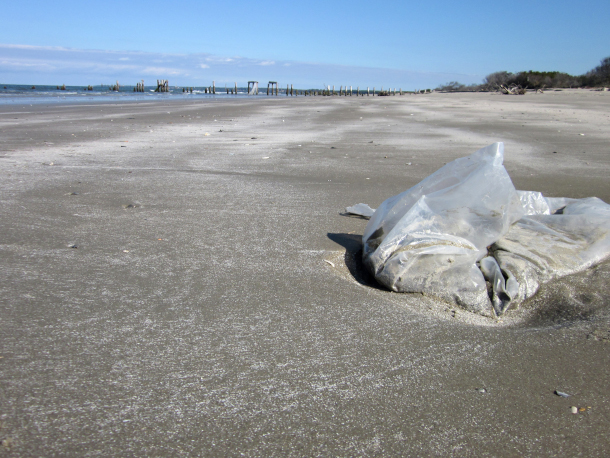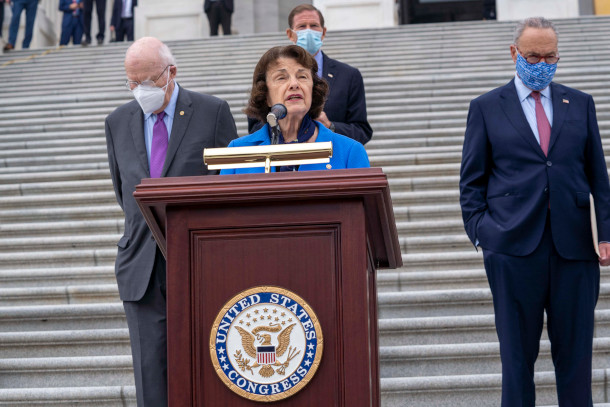Beyond the Headlines
Air Date: Week of October 6, 2023

The United States Department of the Interior has announced plans to phase out single-use plastics on public lands like national parks and wildlife refuges. (Photo: Caitlin Finnerty, Chesapeake Bay Program, Flickr, CC BY-NC 2.0)
This week, Living on Earth Contributor Peter Dykstra and Host Aynsley O’Neill talk about the plan to phase out single use plastics on U.S. public lands, and the late Senator Dianne Feinstein of California’s environmental record. In history, the Erie Canal has a big birthday – 200 years – since its dedication.
Transcript
DOERING: It’s Living on Earth, I’m Jenni Doering
O’NEILL: And I’m Aynsley O’Neill.
O'NEILL: It's just about that time for a look beyond the headlines with our Living on Earth contributor Peter Dykstra. He's joining us now from Atlanta, Georgia. Hey there, Peter, how are you? What do you have for us?
DYKSTRA: I'm doing well, Aynsley, I hope you are too. And the first item for today is that the US Department of Interior is finalizing plans to phase out single use plastic on public lands. And of course, the interior department's public lands cover about 1/5 of the land of the entire United States.
O'NEILL: What are we talking about when we talk about these single use plastics? Peter, is it just the bag that your souvenir comes in or what's going on?
DYKSTRA: Trash bags, food bags from the cafeteria, everything else that's used on the wide open range. And of course, that 1/5 of American land is mostly in the West. Desert, prairie, grasslands, places that a whole lot of people don't normally go except for the national parks. They're included too. One problem here is that they have a phase-out plan that's going to take 10 years without explaining why it would take 10 years to acknowledge the growing problems with plastic and to begin to phase them out. I don't understand that. And they haven't given a full explanation why.
O'NEILL: Yeah, Peter, I'd like to know why myself, but I'd also like to know what else you have for us this week.

Senator Dianne Feinstein served as a United States Senator from California from 1992 to 2023. (Photo: Senate Democrats, Flickr, CC BY 2.0)
DYKSTRA: Well, this past week, Senator Dianne Feinstein died after a long and distinguished career in politics, including three decades in the US Senate. Her legacy on environmental issues is strong but not perfect. She over the years is recognized as being the leading force behind the creation of Joshua Tree National Park in California. She also took the lowest lying land in the United States and elevated it. Death Valley National Park is now at National Park status thanks to Senator Feinstein. Her legacy isn't perfect, though.
O'NEILL: It sounded pretty good so far, Peter, what's making it so complicated?
DYKSTRA: It is good, but she took some heat from fellow Democrats for opposing the Green New Deal in recent years. The League of Conservation Voters scorecard put her at 96% in the most recent full year of Congress. Her lifetime LCV score was 91%. And that's pretty good.
O'NEILL: Well, there's still some time left in that term, who is going to be replacing Senator Feinstein?
DYKSTRA: Gavin Newsom, the Democratic governor of California has appointed Laphonza Butler to fill out the last year of Feinstein's six-year term. Butler has never served in the House or Senate before. But there are three current members of the House, Katey Porter, Barbara Lee, and Adam Schiff. All three have declared to run for a full six-year term in 2024. All three have high LCV scores. So if any of the Democrats win, California's performance on environmental issues in the Senate should stay largely unchanged.
O'NEILL: Well, we'll have to keep an eye on to see what that means for the future of politics in California. But let's talk a little bit about history now. What do you have for us from the history books this week?
DYKSTRA: We'll go back 200 years, I remember it well. On October 8, 1823 the Erie Canal is formally inaugurated in Albany, New York. It would be a little while longer before the canal is fully operational. But a water shipping route from New York City and the Hudson River to Buffalo and the Great Lakes greatly accelerated the westward push of the United States. It also got that cargo around the Appalachian Mountains, which were a big, big obstacle back then. The railroads eclipsed the canal within 50 years. But the Erie Canal still exists if mostly as a tourist trap, rather than as a state-of-the-art means of hauling cargo.

200 years after its inauguration, the Erie Canal is still in use, chiefly for recreational purposes. (Photo: Duncan Hay, National Park Service, Wikimedia Commons, Public Domain)
O'NEILL: Well, as always, Peter, time marches on. Peter Dykstra is a Living on Earth contributor. Thank you so much, and we will talk to you soon.
DYKSTRA: All right, Aynsley, thanks a lot. Talk to you soon.
O'NEILL: And there's more on the stories on the Living on Earth website. That's LoE.org.
Links
Reuters | “US Finalizes Plans to Phase Out Single-Use Plastic on Public Lands”
Grist | “Dianne Feinstein Dies, Leaving a Complicated Legacy on Climate Issues”
Living on Earth wants to hear from you!
Living on Earth
62 Calef Highway, Suite 212
Lee, NH 03861
Telephone: 617-287-4121
E-mail: comments@loe.org
Newsletter [Click here]
Donate to Living on Earth!
Living on Earth is an independent media program and relies entirely on contributions from listeners and institutions supporting public service. Please donate now to preserve an independent environmental voice.
NewsletterLiving on Earth offers a weekly delivery of the show's rundown to your mailbox. Sign up for our newsletter today!
 Sailors For The Sea: Be the change you want to sea.
Sailors For The Sea: Be the change you want to sea.
 The Grantham Foundation for the Protection of the Environment: Committed to protecting and improving the health of the global environment.
The Grantham Foundation for the Protection of the Environment: Committed to protecting and improving the health of the global environment.
 Contribute to Living on Earth and receive, as our gift to you, an archival print of one of Mark Seth Lender's extraordinary wildlife photographs. Follow the link to see Mark's current collection of photographs.
Contribute to Living on Earth and receive, as our gift to you, an archival print of one of Mark Seth Lender's extraordinary wildlife photographs. Follow the link to see Mark's current collection of photographs.
 Buy a signed copy of Mark Seth Lender's book Smeagull the Seagull & support Living on Earth
Buy a signed copy of Mark Seth Lender's book Smeagull the Seagull & support Living on Earth

